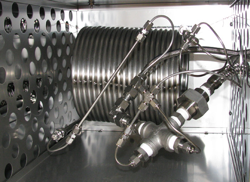
Despite the huge amounts of money that the pharmaceutical industry spends on drug discovery, it is notoriously old-fashioned in how it actually makes its products. Most drugs are made in batch processes, in which the ingredients, often powders, are added in successive and often disconnected steps. The process resembles a bakery more than it does a modern chemistry lab. That could be about to change.
This summer, a team of researchers from MIT and Swiss pharmaceutical company Novartis proved that a continuous production line that integrated several new chemical processes and equipment specially designed for the project could make a higher quality drug faster, and in a less wasteful manner. This more nimble method may even create more opportunities in early drug discovery. In their continuous-manufacturing process, raw ingredients are fed into a parade of heaters, spinners, extractors, and sensors that relay the intermediates through chemical reactions. At the end, round, coated pills fall out.
